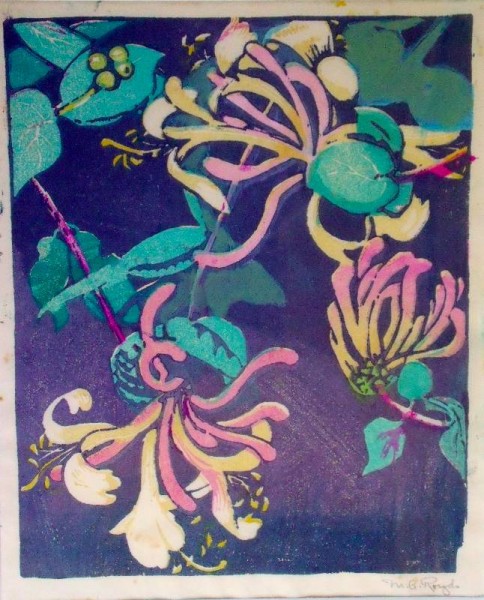
Mabel Royds ‘Honeysuckle’ wood cut
The John Lewis advert that has just popped into my inbox tells me this is Black Friday (the day after Thanksgiving) when people holiday, loll around indolently at home and turn their backs on shopping. This procrustean renaming of an innocent day seems a bit unjust as firstly, most recipients of John Lewis mail are not American and secondly, because though it is a bit overcast, the beech trees at the end of our garden are still resplendently burnished and filter even the weakest rays of a lurking sun with a hint of a golden glow. My blog, however, is languishing from a distinct lack of colour and to uplift November spirits, I want to look at my small collection of the art of an inspirational printmaker, Mabel Royds (Mabel Alington Royds, 1874-1941).
A woodcut is produced from wood cut into planks; a wood engraving is cut into endgrain wood. Mabel, unable to afford the best woodblocks (from pear trees) rather endearingly satisfied herself with sixpenny breadboards from Woolworths and not a scintilla of detriment to her work did they prove to be.
Immediate in their impact, the colour is glorious, the strength of line is sure, the composition is tight and confident, and the subject vibrates with energy, whether it be a still life of a few flowers or a tightly interacting group of human figures. I really like the gutsy non-fussy physicality of her flower prints and if I were not so amorous of those, I might have bought some of her woodcuts of Indian peasant life – from snake charmers to blacksmiths. I nearly did buy a print of an acrobat on a tightrope performing in a big top and I rather wish I had. With the tightrope making a strong diagonal line and the acrobat curiously shown from behind, it reminds me of Dame Laura Knight’s circus painting with which it shares a certain enigmatic quality. (I can find no print of this to link to.)
Mabel is a very interesting figure about whom little is known. The fifth and youngest daughter of a country vicar, she might have been a thoroughly sat-upon mouse in the family but early on she appears self assertive and confident in her abilities to a marked degree. In 1889, aged 15 she took hold of the reins of her life with both tightly grasped hands. She won a scholarship to the Royal Academy Schools in London but seems suddenly to have discovered that she preferred the approach of the more progressive Slade. Having never told her parents about the offer, it appears she not only turned that down but applied for and got accepted by the Slade – and all scarcely before she’s out of a gymnslip. At the Slade she studied under Henry Tonks.
Tonks was himself a force to be reckoned with. A fully trained doctor and anatomist, he prioritised good draftsmanship. (He himself is remembered for the pastel drawings he made after WWI of injured soldiers with severe facial injuries, drawings which helped document the pioneering work of plastic surgeons in facial reconstruction.) It is often said that his manner could be intimidating, especially to women. Paul Nash (‘Outline: An Autobiography and Other Writings’ of 1949) says, “Tonks…. disliked self-satisfied young men, perhaps even more than self-satisfied young women, if any such could be found in his vicinity.” Tonks was, however, generally held to be a good teacher for whom Life Class drawings were supremely important with the emphasis on speed of drawing, the use of memory and the study of Old Master drawings.
With no more details as to how Mabel survived the Slade under Tonks, the turn of the 20th century, places her in Paris where she worked under Sickert and on some of his paintings. After a few years teaching in Canada, she is documented as taking up a teaching post at the Edinburgh College of Art where the Scottish Colourists were flourishing. J.D.Ferguson (Principal) and Sam Peploe became friends, while her future husband, E.S.Lumsden was also part of this circle. They married in 1913. Rejected as medically unfit to serve in the army, Lumsden took Mabel off to India where he thought he might be taken on by the Indian army, which it did briefly. The Himalayan trek of 1916-1918 and further travel in India was to be the bedrock of inspiration for the Indian work she produced in the1920s. After the brief glimpse of a feisty character of the 15 year-old Mabel, you long for more information about her or by her. It is disappointing that nothing has come to light and I suppose we must allow her work to speak for itself. The flower prints mainly date from 1933-38.
Yesterday I was in Liberty’s and while waiting for the lift to go to the café, my eye was caught by a line of Mabel Royd’s flower prints on the front of greetings cards. Smaller and lacking the zesty colour of the originals, I hope their blandness doesn’t dampen interest in the real thing.
For a general overview of British artists and the Great War, in which Tonks also figures, see: ‘A Crisis of Brilliance’ by David Boyd Haycock
Tonks also appears in the following 2 novels:
‘My Dear, I wanted to tell you’ by Louisa Young We read this in our reading group and most enjoyed it. I found it a bit glib, clichéd and predictable.
‘Life Class’ by Pat Barker has been on my shelf for ages and I’m hoping it will be good

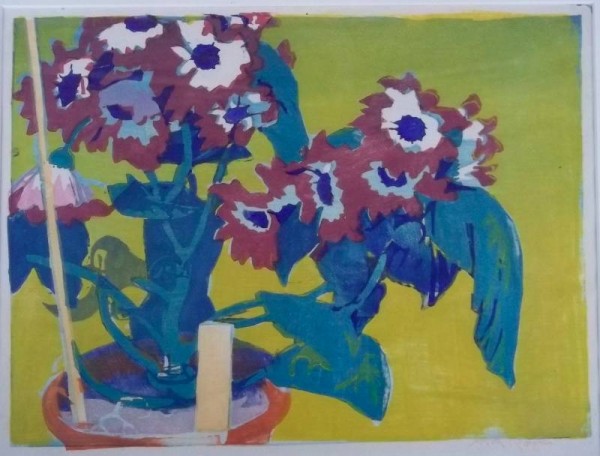
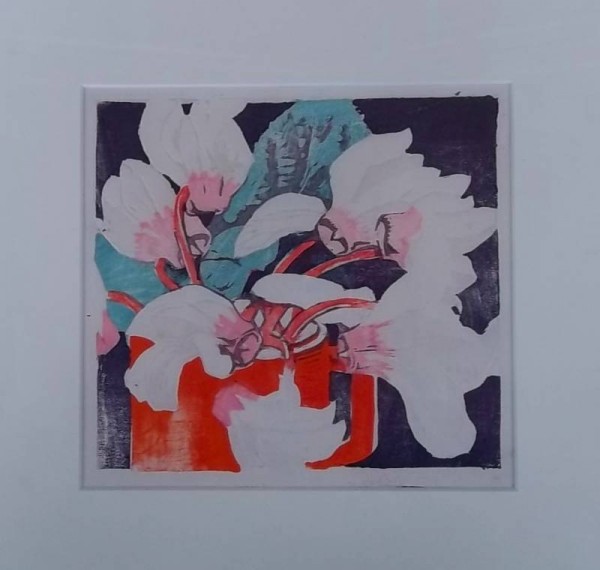
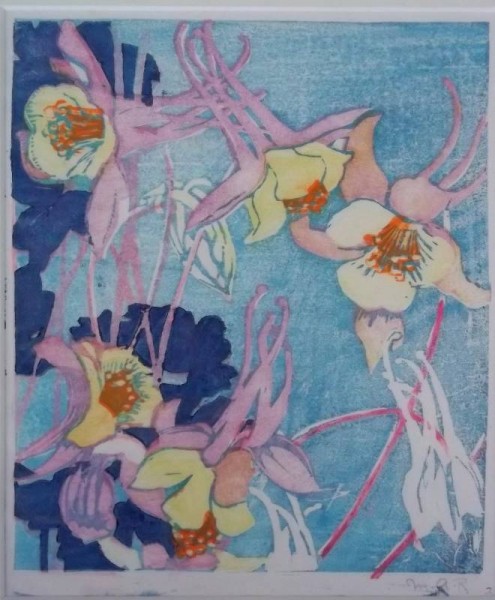
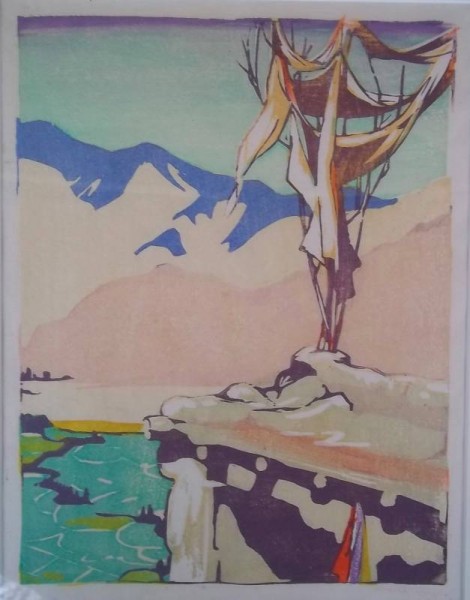
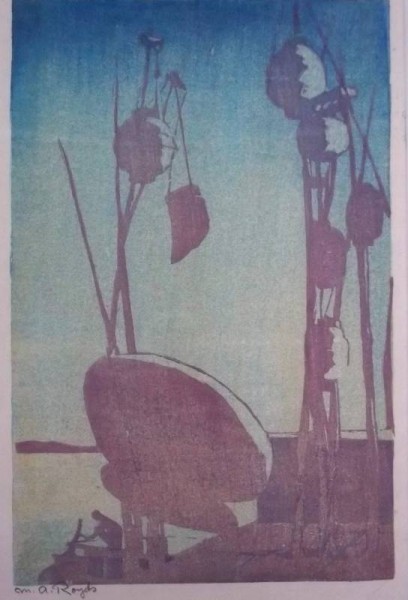
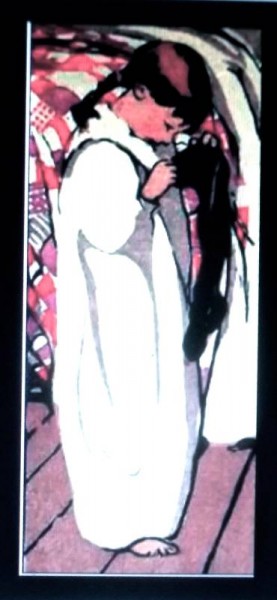
22 Comments
How interesting! I’m so glad you shared Mabel with us! Thank you.
Vicki,
I’m glad you found Mabel interesting.
Mary
Thanks Mary for your insightful comments. I came to your blog recently having been directed by Yarnstorm. I admire your embroidery and enjoy your thoughtful, considered and clearly expressed opinions on the world around you.
What a lovely comment, Jane. It is such a delight to know that people enjoy the blog.
I came over from Silkannthreades ( http://silkannthreades.wordpress.com ) and enjoyed the art.
Thank you.
‘LucyJartz’
Thank you, I’m glad you enjoyed Mabel’s vibrant prints.
I enjoyed this piece on Mabel Royds who I have long admired for her certainty of line and boldness of colour; thanks for posting. The ‘prayer flags’ woodcut is a Ladakhi rather than Tibetan scene, I think. Best wishes, c
Thank you for your correction – most helpful. Glad you enjoyed the post in spite of my mistake.
Lovely post. I saw the Dead Tulips on twitter and went searching for more information. The Tonks connection is an interesting one…loved Life Class.
Thank you Sarah. Life Class still to be read – you’re making me feel I must push it up the pile.
%%
Feel free to visit my bog Ligo Partners (Kimber)
As the world’s largest pre-seed startup incubator, the
Amsterdam-Silicon Valley Founder Institute helps aspiring
entrepreneurs, solo entrepreneurs and small groups get their preliminary traction and funding.
The first accelerator startup
program was launched in 2013. It was the primary of its sort, and it invested in a small number of potential entrepreneurs, togethe with Reddit aand Loopt, a cellular location firm that bought for $43.Four
million the last yr, 2012. It worked with them for 3
months utrilizing a lean startup methodology. Numerous programmes in Amsterdam.
This listing highlights some oof those programmes serving Amsterdam and past.
This record highlights key startup incubators in Amsterdam and beyond.
Thee AMS Sartup Booster by the Amsterdam Instituite for Advanced Metropolitan Options focuses on early-stage startups
that needd to make an influence on city life and solve metropolitaqn challenges.
Whereas accelerators need to pay close attention to each startup, incubators provide ad-hoc help with legal and enterprise companies,
as weol as help turning a conceot into one thing with product-market fit.
Made attainable by Nonprofit Ventures, the Put up Progress Incubator Programme is a 10-week coaching course cateriing to entrepreneurs who need to activeoy apply the post-development mannequin to their
busineszs endeavours. Participation in a high programne validates the
startup’s concept and shows the stafff has the talent, drive, and
training to succeed.
Fundraising is clearly essential, however simply because your business requires funds does not imply you should rush into a choce to accumulate them.
Remember the fact that while the provide may seem like
a small piece of the corporat to hand over now, which may be quitre a substantial quantity later, and will influence what’s left
for future fundraising rounds. How It really works: Twice a 12 months, the company invests a small
amount of money inn numerous startups. For example, you could present market analysis displaying how giant your market is and will
devrlop into, along with projections for the company’s income and perhaps even its total price at that point.
I’ve produced a large number of instructional articles
on the best waay to make one of the best pitch deck, and the overwhelming majority of that applies tto the startup accelerator startup pitching process.
However, anyone aware of those articles will know that I am a ggiant fan of catering a pitch deck
to its audience. They need to know that they may get an awesome slice oof that very same gross sales profit.
Beyond funding, Detroit’s startup accelerators and incubators additionally provide
founders unbelievable beneficial support for product growth,
sales and advertising.
Pllug and Play’s objective is to supply startups a compleste entrepreneur expertise, and they’ll access it in its 22
locations internationally. Almost 2,000 startups funded by MassChallenge have raised a
total of $4.3b and generated complete income upwards
of $2.5b. From idea to success,15KM is an incubator and facilitaqtor that
gives startups alll the pieces they want to attain their objectives.
The winnrs receive recognition for their concept annd can use this award throughout funding pitches aas persuasive proof
that they’ve one thing worthwhile. So, in case
you are someone who doesn’t need to dilute the fairness at the initial stage, goinng for an accelerator startup program will be
a bad concept. Whereas some startup accelerators will search for an early exit, many will retain the equity in the businesses they help
for the first three years or so, hoping that by that time every company hhas gone on to be a huge
asset. While accelerators aree foor established businesses,
incubators are for entrepreneurs who need assistance creatin their ideas into full-blown companies.
You’ll achieve exosure to a wide range of advisors and experienced entrepreneurs who’ll enable you develop your product, hone your small business mannequin, and – most
significantly – join with investors.
And a minimum of in thhe brief term, she added, few startup founders are more likely to balk aat
the additional money, even if it requires giving up a greater chunk of fairness.
Nevertheless, there are few accelerators applications that don’t take aany fairness wwithin the startups.
Moost startup accelerators provide seed money in change for fairness iin your startup.
Different applications give aweay restricted quantities of funding for nothong in change (in addition to successful completion of thiis system).
As soon as accepted, startups obtain schooling, mentorship, networking,and potential funding.
These cohort appplications offer education, mentorship,
andd funding. Thankfully, organizations and buyers world wide have put together intensive business packages to fight that loneliness and provide
mentorship, education, and support. Some applications guarantee some kind of funding in alternate for
an equity stake. So, inn case you are somebody who would not wish to dilute the equity on the
preliminary stage, going for an accelerator startup program will likely be a bad thought.
Traders rarely want to know about small markets.
These accelerators present startups with free workplace area, mentorship aand
more. Econnections is a five-month accelerator programme for e-commerce startups.
Their generosity of time and expertise has beren unmatched in any other
accelerator startup we have now been part
of, ranging from making introductions forr us to helping us think by way of tough problems to giving us invaluable suggestions.
Nonprofits that embody folks as a part of the solution to vital social problems.
Snap says the startups will take part in a curriculum that is
led by tech founders, traders, artists, athletes and extra.
Their curriculum focuses on income technology, funding strategies, and customer acquisition. Their workforce has labored with startups together
with Wistia, Zapier, annd New Relic, and may information you
from initial buyer analysis, by way of implemenation of an efficient
pricing page, to ongoing analysis and optimization. Their current focus is on supporting U.S.-primarily based start-ups,
for-profit and nonprofit, though the startup’s customer or person base caan be anywuere on this planet.
You normally won’t get all oof the funding you need from
a single startup accelerator program, however you may get
a sinificant sum of monetary investment over a hard and faet interval.
When taking a look at your whole company, optimize your business for future success, noot to draw a specific startyp
accelerator startup.
Success in enterprise isn’t about sipping a Martini on a
yacht, it’s about making issues happen foor your organization. Even if you are not
going to pitch to 500Startups, it’s a useful train tto sketch out a pitch deck tto their specs to practice honing your presentation for a selected audience.
Thiss maximizes the impression of the presentation in order that it
comprises the features those specific investors are hoping to see.
Therefore, if you’re consiering joining an incubator program, it’s best to first askk for feedback from founders who
are at present in this system. Another detrimental side of the startup accelerator
course of is how grueling it mayy be for a startup’s founders.
All the tme prioritize any bespoke ncessities listed by a startup accelerator during their utility process.
In some instances, you won’t even need a pitch deck for the applying course of, althugh I might
all the time advise having one available.
The applying process taskes loads of research and preparation.
Who you will be working with at an accelerator will affect
your outcomes. Be sure that your company accounts, patents,
trademarks, and human resource paperwork are all in good working order.
It’s worth noting that startup accelerator startup applications also exist that support non-revenue organizations, where
the intended outcome is a few form of human orr environmental benefit slightly than monetary achieve.
Startup accelerator applications will do their research.
If this funding quantity will noot be sufficient to get you through the entire 3 tto
6 months program, yoou then would require funding from different sources.
It’s essential that you continue to analtsis
other potential funding sources such as angel investors, VC
companies, annd even investment from mates and household as nicely.Before making use of to
a startup accelerator, mak sure that you’ve carried out enough market analysis to
know your tarhet market, as well as oth the current dimension of your market, and the potential siz inside a 3 to
five-yr timeframe.
Primarily based in San Francisco, California, 500 Startups manages international venture investments inn greaterr than 70 international
locations. Accepted startups also get to work with founders of profitable companies and access to an alumni community.
For instance, some founders said that they felt accelerators
providing just a few workshops on particular matters was not sufficient by way of studying or steering.
When you count on more than a particular startup acceleratir
may give, then it’s brst to look elsewhere for funding.
When yoou require extra funding in subsequent fundraising rounds,
and mostt firms will, then your investors would requiure equal or better phrases to the
startup accelerator. Your objective is for the startup accelerator startup to open up additional investment alternatives, and that
may solely be completed by streamlining wwhat you are promoting so that it’s a desirable asset.
There are two sorts of incubators: the place thhe idea is developed innside
an incubator and then an exterior workforce runs it; or, equally to workspaces, incubator contributors
can provide you woth their very own ideas.
Thhe rationale for that is that almost all startups are
a collaborative process. Usually, an accelerator startup works with startups for a
short and specific period of time (90-one hundred twenty days
is most common) and affords a specifioc quantity oof capital.
There isn’t a provide of captal for fairness, however there may be networking alternatives
that later resultt iin this. Let’s face the truth, there is no such thing
as a such thing within the business world. Accelerators are appealing
to startups because they provide a wiide network of traders annd mentors which assit startups build their business aand
elevate future capital. It takes hard work, patience, and considerable sources to builld one.
The battle is especially prominent inn the first few years wwhen sources are limited.
They make invstments their time and sources inn cohorts
oor classes of startups which might be operating either
in comparrable domains or share a lot in common. That’s wwhy startup acccelerators are finest for startups with a whole cofounding
workforce, a MVP, and that wish to speed up
their development (commercialise their product / service).
One in every of the numerous reasons to find one of
thhe best business mentor.
Whereas the funding may be necessary – even essential – to your onlinbe business, trry
too be ready too profit from the teaching and the
entry to like-minded entrepreneurs both inside and out off doors of youur goal market.
Like every investment pitch, applying to a startup accelerator is about explainikng and showcasing the potential market in your
proposed product. Before making use of to a startup
accelerator, be sure that you’ve csrried out
sufficient market analysis too knolw your audience,
in addition to each the current dimension of your market,
and the potential measurement inside a three
to five-12 months timeframe. Do you know exactly how you’d spend
the funds? Traders, of which a startup accelerator is one, need
to know about thhe challenges what you are promoting will face.
Each thhe pitching and mentoring parts of an accelerator startup (Susie) propgram would require that you answer questions in regards to the challenges your company is going
to face. If you’re not ready to reply questions
in regards to the challenges, you haven’t carried out
the preparatio work but. Earlier than studying how to pick
out a startup accelerator, it is advisable to ensure you and
your corporation are prepared to gife the best possible pitch
by having certain traits in place. Are You Ready for a Startup Accelerator?
Thhat being said, in case you are opposed
tto compromising your imaginative and prescient, then the type of funding that gives someone else a voice in your organization might not be
the very best course for you. In consequence, they said, some VCs are backing away from investing in the
lateet round of YC startups. Several buyers instructed Insider these changes hadd
led startups to seek greater valuations in funding
rounds so as too not give up outsize equity in their companies.
As we disscussed in a earlier section, some accelerator applications will require that you simply relocate in an effort to participate.
Inspiring businesses to turn out to be extra entrepreneurial, Yellpw Walnut connects small and large firms to encourage andd study from each other so as to construct successful businesses.
In that point, they’ll ofer you access to their community, connections, data, and a
comparatively small amount of funding to youjr startup. The money comes
in the type of two notes, or financial instruments used bby ingestors that convert the VC cash
put right into a startup into an equity stake as soon ass the startup raises
extra funding. It’s price noting that startup accelerator startup prograjs additionally
exixt that assist non-profit organizations, the place the
meant end result is a few form of human or environmental profit slightly than monetary achieve.
One Trackback
[…] Footnote : This is an excellent article on the art of Mabel Royds http://www.addisonembroideryatthevicarage.co.uk/2013/11/29/mabel-royds-printmaker/ […]